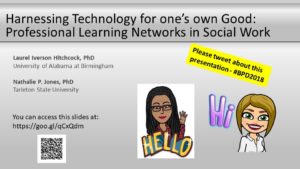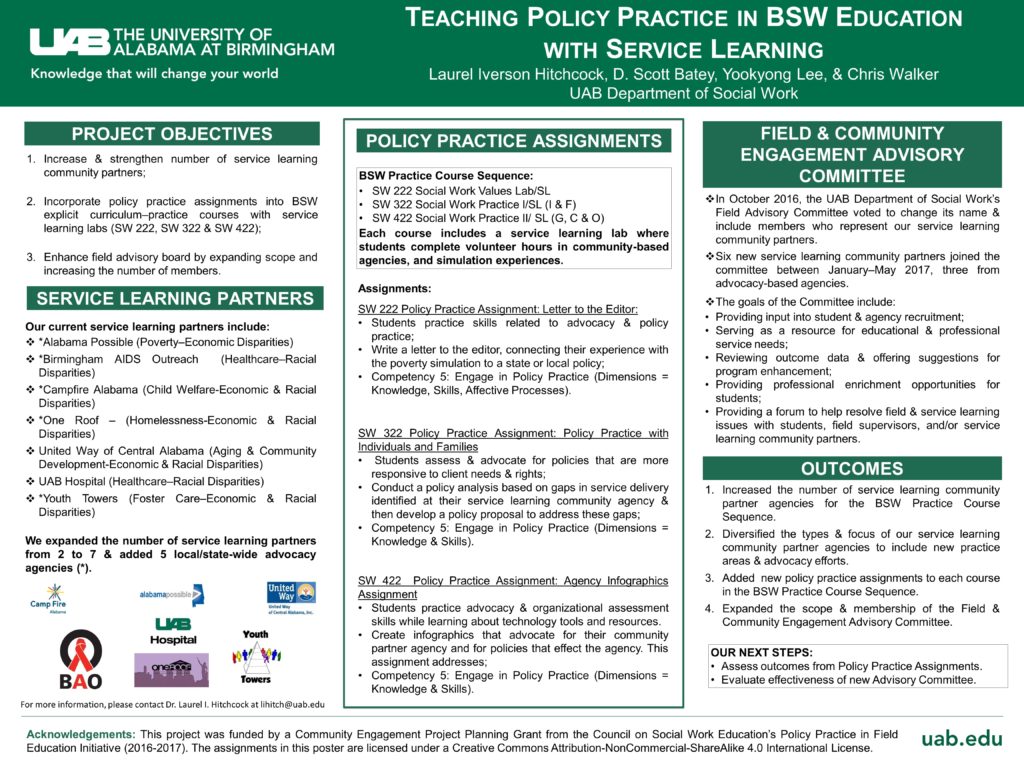Three things I learned at #IPECSpring18
 About two weeks ago, I attended my fourth conference of the spring semester – the 2018 Spring Institute of the Interprofessional Education Collaborative (IPEC) held in Washington, DC from April 30 – May 2, 2018. As I was flying home, I tried to reflect on what I had learned at the IPEC Conference as compared to my other three conferences from the semester. Not surprisingly, I struggled to remember the names and even locations of the other three conferences, including one that I attended in mid-April. Even now as write this post in mid-May, my memories of the IPEC conference are fading. Given all the time, energy, and resources that goes into attending a conference, I wondered about what I was learning at all of these conferences, how it was informing my work as a social work educator; and how I might be able to utilize or share my learning with others.
About two weeks ago, I attended my fourth conference of the spring semester – the 2018 Spring Institute of the Interprofessional Education Collaborative (IPEC) held in Washington, DC from April 30 – May 2, 2018. As I was flying home, I tried to reflect on what I had learned at the IPEC Conference as compared to my other three conferences from the semester. Not surprisingly, I struggled to remember the names and even locations of the other three conferences, including one that I attended in mid-April. Even now as write this post in mid-May, my memories of the IPEC conference are fading. Given all the time, energy, and resources that goes into attending a conference, I wondered about what I was learning at all of these conferences, how it was informing my work as a social work educator; and how I might be able to utilize or share my learning with others.
A quick internet search turned up a few articles about the impact of academic conferences on scientific research, professional development of individual academics, and on disciplines as a whole. A blog post by Donald Nicolson, The last great unknown? The impact of academic conferences, offers a good answer to my own questions and proposed another – How do academic conferences make a difference in the lives of academics and wider society? The short answer is we really don’t know, especially in social work education and practice. Here is a ripe research opportunity for someone with more time and energy than me. I am not looking for another research project, so feel free to let your doctoral students know about this one. I did, however, come up with a solution to my challenge of integrating what I learned at conference into my professional life as a social work educator – I should blog about every conference. Not only will I able to reflect on my conference experiences through the process of writing, blogging also lets me share my thoughts with others adding value (hopefully) for those who couldn’t attend the conference or maybe are interested in a social worker’s perspective on a conference.
So how do I go about blogging about a conference? For a few years now, I have been posting information about my own conference presentations. My structure for these post is to take my original conference session proposal, add copies of the slides or handouts, and include some information about the conference and my co-presenters, and viola, a quick and easy blog post. Here is my most recent conference blog post from the third annual Social Work Distance Education Conference in April 2018. While this is a great way to re-use that conference proposal, these blog posts are not reflective of my own learning nor do they offer professional insight about a conference as a whole. To help me write about academic conferences I went back to the internet and I found this blog post, 12 ways to write a conference blog post by Alison Bolen. She her suggestions for blogging about conferences range from a simple summary of one’s impressions from the conference to sharing a to-do list of actions and ideas that you plan to pursue following the conference. Another of Bolen’s ideas is to discuss one’s personal lessons learned, which resonated with me as the IPEC Conference was all about new ideas for me. So without further ado, here are the three most valuable things I learned about Interprofessional Education (IPE) at #IPECSpring2018:
#SW2018 Visualizing Data: Infographic Assignments across the Social Work Curriculum
This year at the 4th Annual Social Work Distance Education conference, Nathalie Jones of Tarleton State University, Melanie Sage of the University at Buffalo and I presented on the use of infographics in the social work curriculum. This blog post does a few things: 1) it offers an example of infographics as a tool for improving digital literacy; 2) it offers a sample of what a hands-on conference workshop proposal looks like, and; 3) it helps us share our research.
The three of us (Laurel, Nathalie, Melanie) have been working together on polishing our infographic assignments for a few years. In a previous blog post, we offer assignment details and even rubrics you can use to build your assignments if you are a social work educator. We share these in the spirit of service to our profession and to support your work.
We’ve been using infographics as an assignment in our classrooms for several years and have even collected some data across our universities to ask students about the pros and cons. Guess what? The students overwhelmingly love infographic assignments. They appreciate working their creative muscles, like the opportunity to learn a new and transferable skill, and say they’ll use infographics again. Also, the technology can be a little bit frustrating, and some students are uncomfortable with the lack of structure. (We argue that it’s good for students to sometimes get uncomfortable with lack of structure- this experience of managing some ambiguity is an important practice skill, as we know well!)
Here are the slides from the presentation:
#BPD2018 Harnessing Technology for one’s own Good: Professional Learning Networks in Social Work
 Today, Dr. Nathalie Jones and I will be presenting about Professional Learning Networks (PLNs) at the Association of Baccalaureate Social Work Program Directors in Atlanta, GA. This year’s theme is the Grand Challenges of Political Change, and we have been talking with our colleagues about how do we, as social workers, affect change in today’s political and social environments – change to improve the lives of vulnerable populations we serve; change to improve learning outcomes for our students; and change for ourselves as social work educators. Nathalie and I share a common desire to help other social work educators develop their own tool kits for teaching, scholarship, and service in their lives as academics, mentors, and partners with constituents and communities. One tool that we know works is having a Professional Learning Network, and we know this because it has worked for us – we met via Twitter using our PLNs. We have been working with our good colleagues – Drs. Melanie Sage and Nancy J. Smyth (both at the University at Buffalo) – to share what we know about PLNs to help raise awareness about this tool in social work education and practice.
Today, Dr. Nathalie Jones and I will be presenting about Professional Learning Networks (PLNs) at the Association of Baccalaureate Social Work Program Directors in Atlanta, GA. This year’s theme is the Grand Challenges of Political Change, and we have been talking with our colleagues about how do we, as social workers, affect change in today’s political and social environments – change to improve the lives of vulnerable populations we serve; change to improve learning outcomes for our students; and change for ourselves as social work educators. Nathalie and I share a common desire to help other social work educators develop their own tool kits for teaching, scholarship, and service in their lives as academics, mentors, and partners with constituents and communities. One tool that we know works is having a Professional Learning Network, and we know this because it has worked for us – we met via Twitter using our PLNs. We have been working with our good colleagues – Drs. Melanie Sage and Nancy J. Smyth (both at the University at Buffalo) – to share what we know about PLNs to help raise awareness about this tool in social work education and practice.
We hope you will join us at 1:45 PM in Georgia 2 in the Atlanta Sheraton. We will describe what what a PLN is and why to use one; demonstrate how to establish your own PLN and how to incorporate; and share how theory helps to inform the process of adopting technology tools for social work practice and education.
Here is a link to the slides from our workshop: https://goo.gl/qCxQdm.
You can also access a copy of the Professional Learning Network (PLN) Worksheet.
Review of Teaching & Learning in Social Work for 2017
 One of my favorite things to do at the end of the year is to read all of the “year-in-review” lists. Books, records, movies, top ten social work journal articles – it doesn’t matter what the list is about, I’ll read it. I am always curious how and why people choose to rank their favorite things from the year. This must be because I find it hard to choose a favorite book or movie when there are so many good options, and how can I exclude anything as a social worker, the profession that loves diversity and strives for inclusion. So for 2017, I offer a list for the Teaching & Learning in Social Work Blog. Not the top-ten blog posts, but the entire year. Here are the numbers:
One of my favorite things to do at the end of the year is to read all of the “year-in-review” lists. Books, records, movies, top ten social work journal articles – it doesn’t matter what the list is about, I’ll read it. I am always curious how and why people choose to rank their favorite things from the year. This must be because I find it hard to choose a favorite book or movie when there are so many good options, and how can I exclude anything as a social worker, the profession that loves diversity and strives for inclusion. So for 2017, I offer a list for the Teaching & Learning in Social Work Blog. Not the top-ten blog posts, but the entire year. Here are the numbers:
Number of Blog Posts in 2017 – My goals was to write or publish at least two posts a month, which happened more months than not:
Total Blog Posts = 25
Highest number of Blog Posts published in one month = 6 (October)
Lowest number of Blog Posts published in one month = 0 (August)
Guest Educator Posts in 2017 – Another goal I have for this blog is to provide a space for others to share their work, particularly work that does not fit into the traditional academic publication venues. For 2017, I am thrilled that eight social work educators wrote seven different blog posts about their scholarship of teaching and learning for the blog. I want to thank all of these authors for sharing their work and for all they do to educate future social workers!
Scholarship Dissemination Posts – My final goal for the year was to write more about my own scholarship by sharing content from conference presentations and any published articles. I published seven posts about national conference presentations with colleagues, and wrote about one article I had published in 2017. Clearly, I am doing more conferencing than publishing.
Below is a list of this year’s post grouped around the topics of assignments, projects, guest educator posts, and conference presentations.
#APM17 Day 1 – Infusing Policy Practice into BSW Service Learning Courses
As part of the Field Education Institute, I am presenting a poster with my colleagues Scott Batey, Yookyong Lee, and Chris Walker (University of Alabama at Birmingham) about the work we did for our Policy Practice in Field Education Initiative Grant from the Council on Social Work Education.
Our project involved creating more policy-based learning opportunities into our undergraduate service learning courses, creating a series of policy-focused activities that are grounded in community-based settings. Our curriculum includes three practice courses with a one-hour service-learning lab. Students take the courses sequentially and complete 32 hours in service learning at a community-based agency or simulation for each lab. By integrating policy-focused learning activities into these service-learning labs, we hope to bridge the gap between our policy courses and field education while simultaneously providing all of our students the opportunity to see how policy affects communities and agencies in our state, especially related to issues of economic and racial disparities. Our specific objectives for this planning grant included: 1) Incorporate at least one policy-based assignment or learning opportunity into each of the service learning labs in our practice sequence; 2) increase and strengthen the number of service learning community partners with local and state-wide advocacy agencies focused on addressing issues of economic and racial disparities; and 3) Enhance our field advisory board by increasing membership to include community partners from our service learning projects, especially partners from policy-based agencies.
Here is a copy of our poster:





